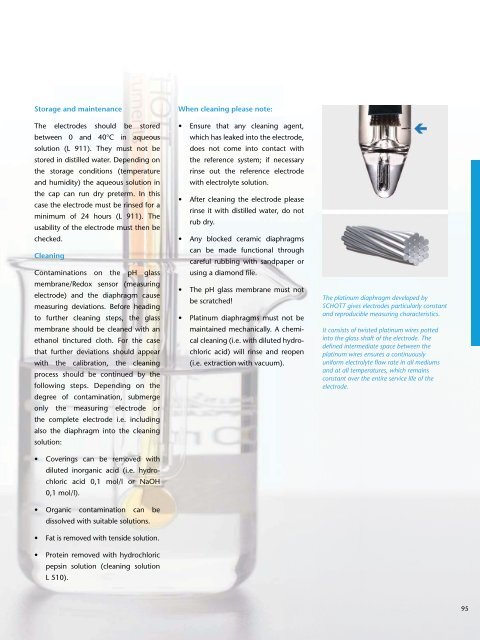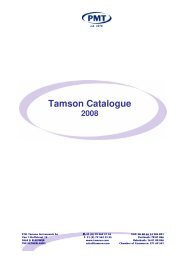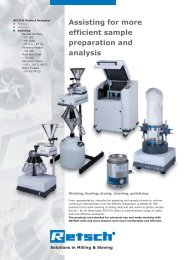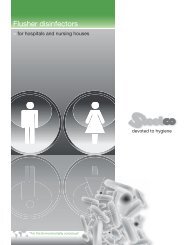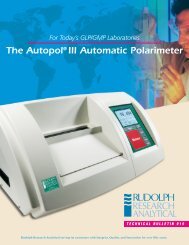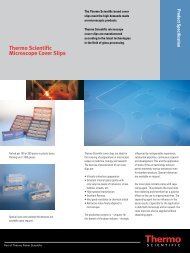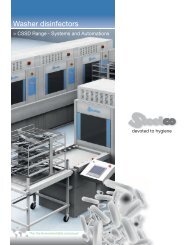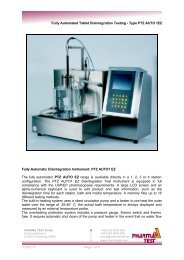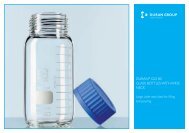Laboratory Products
Laboratory Products
Laboratory Products
You also want an ePaper? Increase the reach of your titles
YUMPU automatically turns print PDFs into web optimized ePapers that Google loves.
Storage and maintenance<br />
The electrodes should be stored<br />
between 0 and 40°C in aqueous<br />
solution (L 911). They must not be<br />
stored in distilled water. Depending on<br />
the storage conditions (temperature<br />
and humidity) the aqueous solution in<br />
the cap can run dry preterm. In this<br />
case the electrode must be rinsed for a<br />
minimum of 24 hours (L 911). The<br />
usability of the electrode must then be<br />
checked.<br />
Cleaning<br />
Contaminations on the pH glass<br />
membrane/Redox sensor (measuring<br />
electrode) and the diaphragm cause<br />
measuring deviations. Before heading<br />
to further cleaning steps, the glass<br />
membrane should be cleaned with an<br />
ethanol tinctured cloth. For the case<br />
that further deviations should appear<br />
with the calibration, the cleaning<br />
process should be continued by the<br />
following steps. Depending on the<br />
degree of contamination, submerge<br />
only the measuring electrode or<br />
the complete electrode i.e. including<br />
also the diaphragm into the cleaning<br />
solution:<br />
• Coverings can be removed with<br />
diluted inorganic acid (i.e. hydrochloric<br />
acid 0,1 mol/l or NaOH<br />
0,1 mol/l).<br />
• Organic contamination can be<br />
dissolved with suitable solutions.<br />
• Fat is removed with tenside solution.<br />
• Protein removed with hydrochloric<br />
pepsin solution (cleaning solution<br />
L 510).<br />
When cleaning please note:<br />
• Ensure that any cleaning agent,<br />
which has leaked into the electrode,<br />
does not come into contact with<br />
the reference system; if necessary<br />
rinse out the reference electrode<br />
with electrolyte solution.<br />
• After cleaning the electrode please<br />
rinse it with distilled water, do not<br />
rub dry.<br />
• Any blocked ceramic diaphragms<br />
can be made functional through<br />
careful rubbing with sandpaper or<br />
using a diamond file.<br />
• The pH glass membrane must not<br />
be scratched!<br />
• Platinum diaphragms must not be<br />
maintained mechanically. A chemical<br />
cleaning (i.e. with diluted hydrochloric<br />
acid) will rinse and reopen<br />
(i.e. extraction with vacuum).<br />
The platinum diaphragm developed by<br />
SCHOTT gives electrodes particularly constant<br />
and reproducible measuring characteristics.<br />
It consists of twisted platinum wires potted<br />
into the glass shaft of the electrode. The<br />
defined intermediate space between the<br />
platinum wires ensures a continuously<br />
uniform electrolyte flow rate in all mediums<br />
and at all temperatures, which remains<br />
constant over the entire service life of the<br />
electrode.<br />
95


